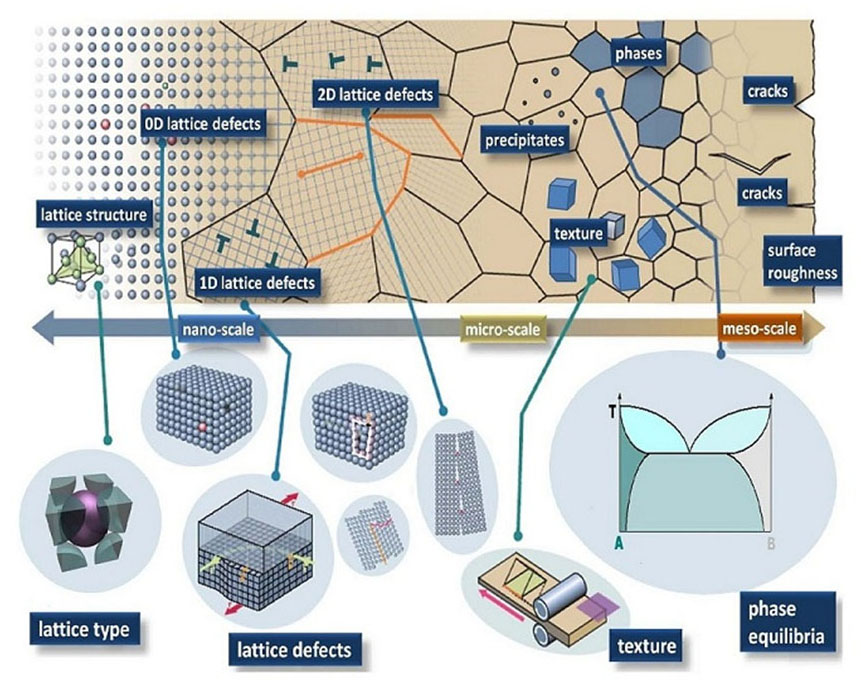Nowadays, subjects such as grain& grain boundary, crystalline settling of material, their slipperiness, alteration of the shapes of crystals as a result of loading, grain growth and the effects of boundary in reinforcement of materials has increased the importance of microstructural studies. In RRVI institute, this research topics can be summarized topically as follows:
- Dual Phase Steels
- Multiscale Modeling
- Phase Field
- Very High Cycle Fatigue

-
Dual Phase Steels:
During the last decade, advanced high-strength steels (AHSS) such as dual-phase (DP) and TRIP steels have been introduced for metal forming processes, especially in automotive industry for the purpose of weight reduction and saving energy. DP steel can be considered as one of the most important steels employed in automotive industry due to its high ultimate strength, low yield stress, continuous yielding behavior, and high rate of strain hardening. DP steel which was firstly introduced by Hayami and Furukwa is composed of hard martensite islands distributed in a ductile ferrite matrix. This steel owes its high formability and high strength to ferrite and martensite phases, respectively. In order to predict the mechanical and deformational behavior of DP steels, it is highly imperative to have a deep understanding of the key factors responsible for their ductile failure. Although DP steels show homogenous deformation at macro-scales, their plastic deformation is severely inhomogeneous at micro-scales. This can be related to their microscopic morphology and inhomogeneity of microstructures. Given the importance of microscopic morphology and inhomogeneity of microstructure and so the strain localization in fracture processes, we have combined analyses of in-situ experiment, strain calculation by image processing of the measured results, and numerical simulation for investigation.
-
Multiscale Modeling:
Multiscale material modeling offers the promise of being able to determine material properties from simulations or measurements of the microstructure and then representing these effects on material behavior at a larger size scale. One application of this method is in determination of material anisotropy from crystalline orientation distribution functions to calibrate anisotropic yield surfaces used in full scale sheet forming calculations. The cases which are investigated under micro dimensions give more acceptable results in comparison with macro dimensions. The obtained information from micro dimensions are then used for estimating in macro dimensions.
-
Phase Field:
The ability to control the evolution of crystallographic texture and grain sizes in polycrystalline materials under the action of stimuli e.g. thermal, mechanical, electrical, etc. is a fundamental subject of study in engineering and materials science practice since the overall mechanical and/or electrical properties of a structure/component highly depend on the microstructure it possesses. For polycrystalline bodies, grain boundary motion serves as an important mechanism for microstructure evolution in materials encountered in large-scale structures e.g. rock-forming minerals, polar ice sheets, solar cells, etc. and small-scale microelectronic and nano electronic mechanical systems-type devices e.g. interconnects, microelectronic switches, chemical sensors, infrared light detectors, etc. The phase-field method is used to study the grain growth and microstructure evolution in polycrystalline metals. The phase-field method which is based on a diffuse-interface description of a grain boundary provides a great platform to study realistic i.e. three-dimensional grain growth and texture evolution due to the relative straight forwardness in its numerical implementation.
-
Very High Cycle Fatigue:
Nowadays there is a growing demand for the development of fast and robust fatigue life prediction methods in the very high cycle fatigue (VHCF) domain. The VHCF regime is associated with stress amplitudes lower than the conventional fatigue limit and as a result, numbers of cycles higher than 107. This study explores the VHCF phenomenon using experimental data of ultrasonic fatigue testing of some tool steel grades. The causes and mechanisms of VHCF failures are investigated by means of high resolution scanning electron microscopy, and in relation to the existing theories of fatigue crack initiation and growth. A particular attention is paid to the fatigue crack initiation, as it has been shown that in the VHCF range crack formation consumes the majority of the total fatigue life. Understanding the driving forces for the fatigue crack initiation is a key to improve properties of components used for very long service lives. Finite element modelling of VHCF testing is added as an additional perspective to the study by enabling calculation of local stresses at the fatigue initiating defects.



 Subscribe to RSS Feed
Subscribe to RSS Feed